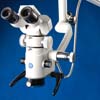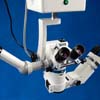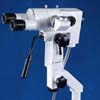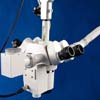ART.V.-Rupture of the Choroid
At the moment when rupture of the choroid takes place, it is generally accompanied with more or less abundant hemorrhage, which prevents the direct diagnosis of the lesion.As the blood id absorbed, we can, on opthalmoscopic examination, recognize rupture of the choroid by the presence of a band which is at first yellowish, but afterwards becomes white, and is limited by a pigmented border. In most cases we find these rupture not far from the optic nerve, surrounding part of the papilla; but it is probable that they also exist in the anterior periphery of the choroid, causing hemorrhage into the vitreous body.
The retinal vessels pass over the band if the retina itself be uninjured.
The disturbance vision depends on the intensity of the lesion, which may simultaneously produce hemorrhage in the anterior chamber and vitreous body.
In the other cases we may have, as a consequence of the rupture, inflammation of the choroid and retina. Nevertheless, vision, which is at first much affected, may be gradually re-established and regain its normal condition. Even in such cases we must give a guarded prognosis, for the contraction of the cicatrical tissue has been known to produce separation of the retina at a later stage (Saemish)
The treatment should be antiphlogistic in the early stages-leeches, compress and bandage. We must carefully watch the injured eye for some time, on account of the choroiditis which may be developed.
For the same reason, the eye must be kept at rest for a long period. Injections of strychnia may be use when, after the wound has healed, the visual acuteness remains impaired.
Back to Resources
call toll-free:  or email
or email

 or email
or email
Categories
Categories
Dental
Dental Microscopes
Dental Microscopes
Ophthalmic
Ophthalmic Microscopes
Ophthalmic Microscopes
Gynecology
Gynecology Colposcopes
Gynecology Colposcopes




